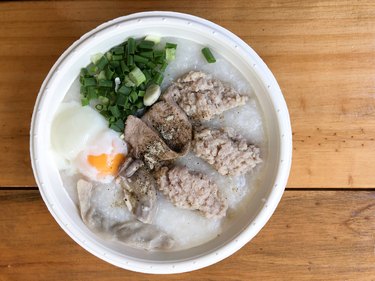
Millions of Americans have never heard of congee, but it's as common in many Asian countries as oatmeal or mac and cheese. In its most basic form, congee calories are relatively low, although it's not very nutritionally rich.
Adding fruit, veggies and other healthy items to your bowl can help boost congee's nutritional profile without taking away from its essence.
Video of the Day
Video of the Day
Mix It Up
Congee is another name for rice soup or rice porridge. It's made by cooking rice in a large amount of water for a long time so that the grains lose their structure, soften and distribute their starch throughout the mixture. Congee may be sweet or savory and can contain ingredients as basic as rice and water or as complex as spices, marinated meat, nuts, fresh herbs and other garnishes.
The ingredients in a particular type of congee are really what make up its nutrition facts; rich ingredients equal a high-calorie and high-fat bowl of porridge, but keeping the dish simple also keeps the calorie and fat counts low.
Congee Nutrition Facts
According to nutritionix.com, 1 cup of rice porridge, or congee, has:
- 214 calories
- 5.8 grams of fat
- 11 grams of protein
- 30 grams of carbohydrates
- 2.9 grams of fiber
In contrast, according to the USDA, 1 cup of plain cooked white rice has:
- 205 calories
- 0.4 grams of fat
- 4.3 grams of protein
- 44.5 grams of carbs
- 0.6 grams of fiber
Try it Sweet or Savory
If you want sweet congee rather than savory but don't want all the calories that usually come along with added sugar, try making up a congee recipe as if it were a bowl of oatmeal. Add just a teaspoon or less of brown sugar or honey, and liven up the flavor and texture with nutritious additions like wheat germ, toasted nuts and fresh berries.
In a savory version, add fat-free, low-sodium chicken broth and protein-rich peanuts. You can also experiment with using brown rice for congee instead of white rice. In 1 cup of cooked rice, brown offers more than three times the amount of dietary fiber, according to the USDA.
Fiber is an important nutrient that improves digestive health and helps to lower your risk of heart disease by lowering blood cholesterol levels and controlling blood sugar spikes, according to the Harvard School of Public Health.
Read more: What Is the Nutritional Value of Oatmeal?
Save on Salt
Because it contains relatively few vitamins and minerals and is largely a vehicle for simple carbohydrates, congee isn't the most nutritious food, and it's not likely to keep you full for long periods of time unless you make it with whole grain rice or use high-fiber additions.
However, congee is low in sodium, so it's one comfort food you don't have to feel guilty about downing on a regular basis. According to the American Heart Association, healthy adults should consume no more than 2,300 milligrams of sodium per day. If you've got high blood pressure or other risk factors for heart disease, that recommendation drops to 1,500 milligrams.
- Center for Dairy Research: "Protein Enhanced Congee"
- USDA National Nutrient Database: "Rice, Brown, Medium-Grain, Cooked"
- Nutritionix.com: "Rice Porridge"
- USDA National Nutrient Database: "Rice, White, Long-Grain, Regular, Enriched, Cooked"
- American Heart Association: "How Much Sodium Should I Eat Per Day?"
- Harvard School of Public Health: "Fiber"